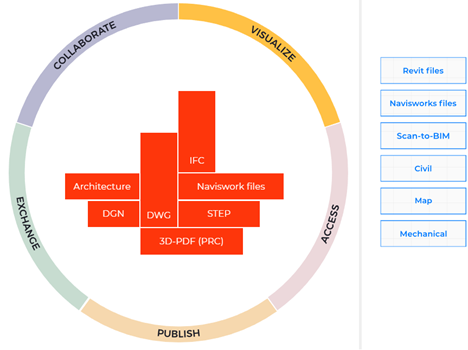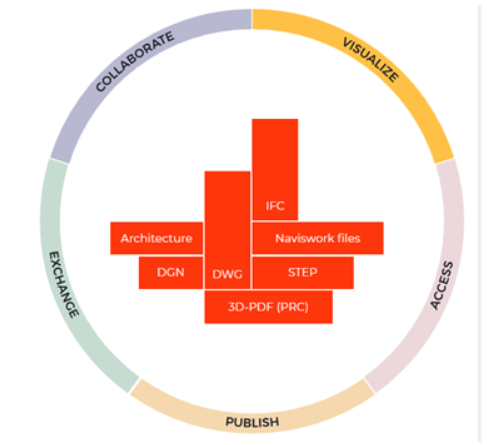Addressing the issues of Scan to BIM for existing buildings and making the translation of proprietary MCAD formats more user-friendly.

There are behind-the-scenes software companies that at least once a year show off what they can do, and what they plan to do next year. This occurs at the annual Open Design Alliance (ODA) Summit, where engineering software professionals come together to discuss industry trends, best practices for CAD and BIM development, and advancements in ODA technologies.
The conference is run by the Open Design Alliance, a non-profit association of over 1,000 corporate firms with names like Autodesk, Bentley Systems, and Dassault Systèmes that use the ODA’s programming tool kits to translate and work with CAD files. Other members use the tools internally, creating their own design and viewing systems.
The ODA was known first for providing tools that accessed data stored in Autodesk’s DWG format. In the years that followed, they were asked by Bentley Systems to handle its MicroStation DGN format, by BuildingSmart to provide IFC programming tool kits for architectural software, and more recently by the PDES organization to do the same for STEP in mechanical design.
The ODA is also renown for not working with CAD vendors. It had occurred the wrath of Autodesk over reverse engineering the DWG format, attracting a lawsuit that has since been settled. Similarly, the ODA reverse engineered the Revit file format without cooperation from Autodesk. Today, however, Autodesk is a member of ODA, specifically for access to the IFC tool kit.
ODA Summit 2022
The ODA’s annual conference is important for us to take in because it’s there that we learn about new features users can expect to get in next year’s CAD programs. Although, some implementations can take years to complete, such as two new ones announced this year.
The first concerns structures that have already been built. While the marketing from CAD vendors tends to concentrate on sexy new designs, the bulk of work being done is with existing buildings. If plans don’t exist or are inaccurate (due to settling over decades or repeated renovations), then the building’s inner and outer dimensions have to be re-input into a CAD system.
There are ways of measuring them manually, but the technology exists to do it semiautomatically: Laser scanners set up inside and outside buildings record walls, floors, and furnishings with millions of points, each with an X, Y, Z coordinate. Each 3D scan, called a point cloud, is merged with the others to create a single, massive point cloud of the building, consisting of billions of points. That, so far, was the easy part.
Now, software is needed that works in reverse, determining which groups of points are arranged like walls, which like floors, and which like furnishings, eventually turning them into 3D models with descriptive data. This workflow is Scan to BIM and is currently the toughest programming problem being worked on in the CAD world.
The ODA was not the first to tackle the problem; what it is doing instead is coordinating a group effort by (so far) 11 CAD vendors, each one contributing to the overall solution. So far, the software can convert point clouds to surfaces.
Another new project is similarly coordinated by the ODA: the translation of proprietary mechanical CAD formats, such as SolidWorks, Autodesk’s Inventor, and Siemens’ NX. Again, this is not a problem that needs solving; a half dozen translation firms already exist, some for decades. In this case, members of the ODA say they want to get away from opaque and expensive licensing. The ODA notes that it tried working with existing translation companies but found that none would agree to ODA terms.
“It might take us a few years to get up and running, but this is not as complicated as [reverse engineering] DWG,” ODA President Neil Peterson told me. “We are looking only to read and visualize data and objects, not looking to write proprietary formats.” ODA members can write to open formats like STEP.
A hundred years of support
CAD software grew up alongside the rest of the fast-moving computer industry, which considers “long-term” support to be as generous as three or four years before software, hardware, and file formats are changed to once again refill corporate coffers through upgrades. As a result, the CAD industry has a poor understanding of the building and manufacturing industry’s need for long-term stability in data. Here, we’re talking a hundred years.
Aircraft builders, ship constructors, and power plant operators need access to stable CAD formats that handle decades-old files decades into the future. Consider the B-52 aircraft, first flown in 1952 and one that Boeing says is good “for decades to come.” There are your hundred years.
So far, the ODA is offering hundred-year commitments to Autodesk’s DWG and Revit RVT, Bentley Systems’ DGN, and Adobe’s PDF/PRC formats. One way the ODA does this is through a Git-like version history that stores all revisions made to DWG files; another is by maintaining decades-old versions of the DWG format itself.
To do this, the organization intends to stay in business for another hundred years. Peterson told me that “it is an intention, not a fixed 100-year period. The goal is to keep the organization going for 100–200 years. We can only be shut down if members decide to do it; we cannot be acquired and cannot be shut down by consolidation.”
The alliance has offered its long-term support to any CAD vendor. None have taken up the offer because “vendors are primarily interested in interoperability with competitors, not the longevity of their own formats,” said Peterson.
Editor’s note: For an in-depth look at the current state of DWG, download the Jon Peddie Research report titled 2022 Value of DWG and Exchange Formats, available on GraphicSpeak.






